Birding the Adirondack Mountains:
Spring Birding at the Paul Smiths VIC
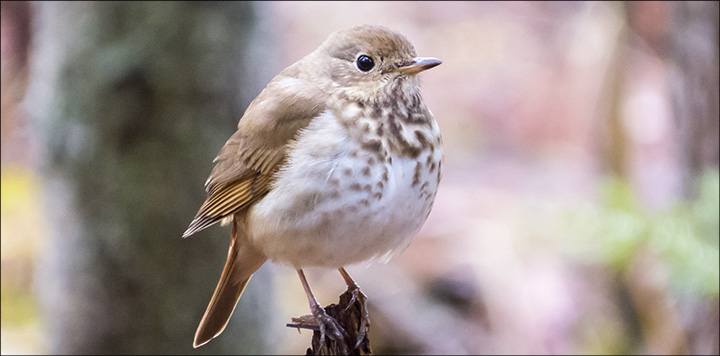 Adirondack Birding: Hermit Thrush on the Barnum Brook Trail (3 May 2016)
Adirondack Birding: Hermit Thrush on the Barnum Brook Trail (3 May 2016)
List of Birds at the Paul Smiths VIC
| This page is no longer being updated. For an updated version of this material, see: Birds of the Adirondacks |
Around April, the many bird species that spend their winter in warmer climates to the South make their way back to the Adirondack Mountains to find partners and rear a family. One of the many joys of early spring birding in the Adirondacks – in addition to the absence of deciduous foliage to impede visibility and the relative paucity of biting insects – is the pleasure of welcoming back the migrants from the South. By the end of April, birders can expect to begin seeing the earliest-arriving migrants. The influx of our summer residents continues through May. Below are some of the birds to watch and listen for.
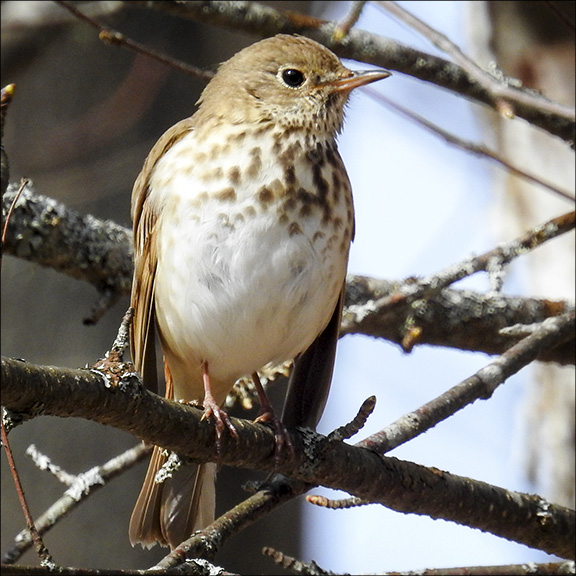
Hermit Thrush: The Hermit Thrush generally puts in an appearance along the VIC trails by late April. The Hermit Thrush is a short-distance migrant. It winters in the southern US, rarely crossing the Gulf of Mexico. In eastern and central North America, males begin migrating north in March, arriving at our part of the Adirondack Mountains in late April. The Hermit Thrush breeds in a wide range of forest types, including coniferous, deciduous, and mixed forest. It is commonly seen at the VIC in the forest under-story along virtually all the trails, and even more commonly heard, singing its haunting, evocative song.
Ruby-crowned Kinglet: Another short-distance migrant is the Ruby-crowned Kinglet. In contrast to the Golden-crowned Kinglet, which routinely winters in areas where nighttime temperatures can fall below –40° Fahrenheit, the Ruby-crowned Kinglet migrates to the southern and southwestern United States and Mexico for the winter, returning to our part of the Adirondack Mountains by about mid-April. Look for the Ruby-crowned Kinglet in spruce-fir forest and mixed woods along virtually all of the VIC trails. While this tiny bird may be difficult to locate as it flits through the branches, it is easily found by its distinctive, rambling song that builds to an incredibly loud ending.
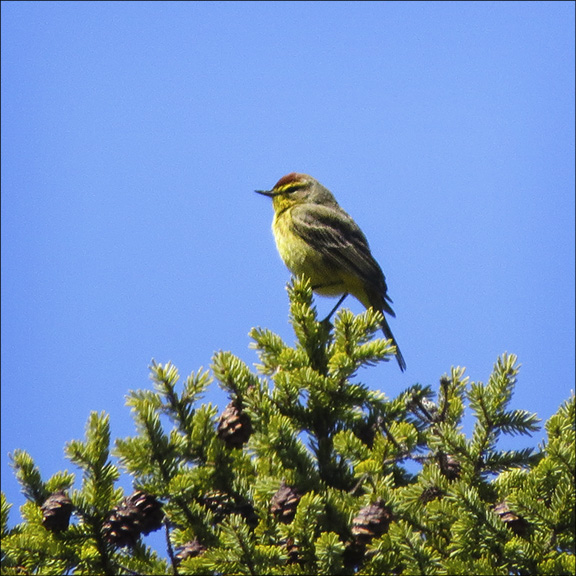
White-throated Sparrow: Another returning summer resident with a distinctive song is the White-throated Sparrow. A short-distance migrant, the White-throated Sparrow winters in the southern parts of the US and returns to its breeding range in northern New York, New England, and Canada when snow melt exposes portions of the forest floor. Listen for its evocative "oh-sweet-Canada-Canada" as these sparrows forage near the ground and flit about low in the bushes along virtually all the VIC trails.
Palm Warbler: The Palm Warbler is among the earliest warblers to return to its familiar haunts at the VIC. This attractive, rusty-capped warbler spends the colder months in the southern US and Caribbean, and sets off for its northern breeding grounds in April. This bird is usually seen at the VIC by late April. Listen for its continuous, flattened trill and watch for its bobbing tail on Barnum Bog, which can be accessed by the boardwalk on the Boreal Life Trail. The Palm Warbler is a ground nester and forager, but is most easily seen when it perches on the top of the Black Spruce treed which flourish in Barnum Bog.
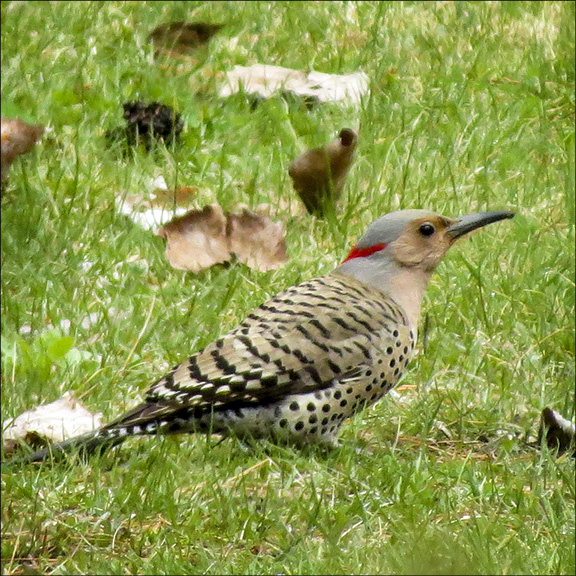
Yellow-rumped Warbler: Another early-returning warbler is the Yellow-rumped Warbler. This warbler winters in the southern United States, Mexico, and the western Caribbean, migrating north to our part of the Adirondacks by about late April. It's whistled warble can be heard along most of the VIC trails. It is especially common on the edges of Barnum Bog. Look for Yellow-rumped Warblers perched on the outer limbs of trees or flitting through the canopies of coniferous trees as they forage.
Northern Flicker: Although several of our woodpeckers such as the (Downy Woodpecker and Hairy Woodpecker) are year-round residents, others are migratory. The Northern Flicker is an example. Our flickers leave the VIC in the late autumn and return to the Adirondacks in early spring. Look for this handsome woodpecker foraging on the ground for ants and beetles, especially near Monarch Meadow by the VIC building. If you flush a flicker from a feeding spot on the ground, you'll see a flash of yellow on the wings and an obvious white rump patch.
Yellow-bellied Sapsucker: The Yellow-bellied Sapsucker is the only woodpecker in eastern North America that is completely migratory. Although a few individuals remain throughout much of the winter in the southern part of the breeding range, most head farther south, going as far south as Panama. Yellow-bellied Sapsuckers depart their wintering grounds in late March and early April, arriving in our part of the Adirondacks in late April and early May to find partners and rear families. Look for them on the trunks of trees, perching upright and leaning on their tails like other woodpeckers.
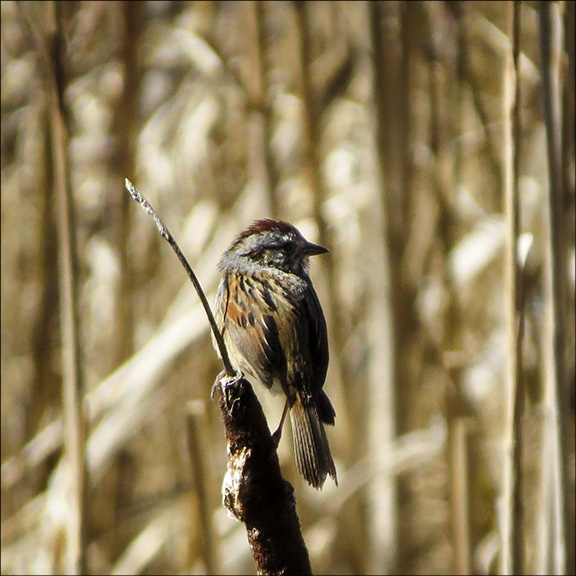
Swamp Sparrow: Late April and May is also a good time to monitor the returning birds who make their home near or on Heron Marsh. Listen for the trill of the Swamp Sparrow, which winters in the southern US and Mexico, returning to our part of the Adirondack Mountains in late April and early May. Although the Swamp Sparrow's song is similar to the faster trill of the Chipping Sparrow, if you hear a slow, simple trill from a sparrow-like bird on a marsh, it's probably a Swamp Sparrow. This aptly-named sparrow nests in wetland habitats. Ours can be found on Heron Marsh, where you can see it perching on cattails near the overlooks on the Heron Marsh Trail and the Barnum Brook Trail.
American Bittern: The American Bittern -- a familiar resident of Heron Marsh -- also returns around late April. This bittern spends its winters on coastal plains in the southern US and further south in Mexico and Bermuda. It leaves for its breeding grounds in the northern US and southern Canada in early spring. It usually arrives in the Adirondacks by late April or early May. Listen for its distinctive three syllable "pump-er-lunk" song and watch for it stalking through the vegetation on Heron Marsh, head in the air imitating a stick.
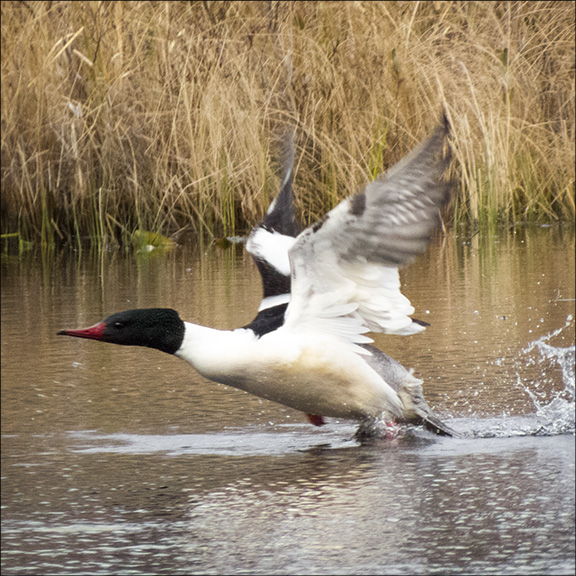
Common Merganser: Late April and early May is also a time when the migrating ducks return. The Common Merganser spends its winters on large lakes, rivers, and reservoirs in the southern and coastal regions of their breeding range, and in additional wintering grounds across the northern and western United States. These ducks are among the first ducks to reappear in our part of the Adirondacks. Watch for them from the overlooks on the Heron Marsh Trail, starting in mid-April. The males have white bodies, dark green heads (which appear black in most lights), and a slender, serrated red bill. The females are slate grey with a chestnut head.
Ring-necked Duck: Our Ring-necked Ducks also reappear around this time. Ring-necked Ducks winter inland along the Gulf of Mexico and southern Atlantic coasts. They depart from their wintering sites in February and can usually be found at the VIC from mid- to late April on. Look for them resting in the vegetation along the edges and islands of Heron Marsh. Despite the name, the neck rings on the Ring-necked Duck are rarely discernible from a distance, so look for this bird's distinctive, peaked head to help you identify it. Adult males are decked out in gleaming black, gray, and white and have a prominent white ring on the bill. Females are rich brown with a delicate face pattern, often seen on Heron Marsh later in the season with a row of ducklings.
References
- eBird Checklist. Paul Smiths College Visitor Interpretive Center, Franklin County, New York, US. Sat Apr 16, 2016 11:30 AM. Retrieved 25 April 2016.
- eBird Checklist. Paul Smiths College Visitor Interpretive Center, Franklin County, New York, US. Mon Apr 25, 2016 9:37 AM. Retrieved 5 May 2016.
- eBird Checklist. Black Pond, Franklin County, New York, US. Mon Apr 25, 2016 8:50 AM . Retrieved 5 May 2016.
- eBird Checklist. Paul Smiths College Visitor Interpretive Center, Franklin County, New York, US. Thu Apr 28, 2016 12:30 PM. Retrieved 5 May 2016.
- eBird Checklist. Paul Smiths College Visitor Interpretive Center, Franklin County, New York, US. Fri Apr 29, 2016 8:45 AM. Retrieved 5 May 2016.
- eBird Checklist. Paul Smiths College Visitor Interpretive Center, Franklin County, New York, US. Sat Apr 30, 2016 9:51 AM. Retrieved 5 May 2016.
- eBird Checklist. Paul Smiths College Visitor Interpretive Center, Franklin County, New York, US. Tue May 03, 2016 8:20 AM. Retrieved 5 May 2016.
- eBird Checklist. Black Pond, Franklin County, New York, US. Tue May 03, 2016 7:30 AM. Retrieved 5 May 2016.
- eBird Checklist. Paul Smiths College Visitor Interpretive Center, Franklin County, New York, US. Fri May 06, 2016 9:24 AM. Retrieved 7 May 2016.
- eBird Checklist. Black Pond, Franklin County, New York, US. Sat May 07, 2016 11:48 AM. Retrieved 7 May 2016.
- eBird Checklist. Paul Smiths College Visitor Interpretive Center, Franklin County, New York, US. Sat May 07, 2016 9:06 AM. Retrieved 7 May 2016.
- Cornell Lab of Ornithology. The Birds of North America Online. Subscription Web Site. Retrieved 3 May 2016.
